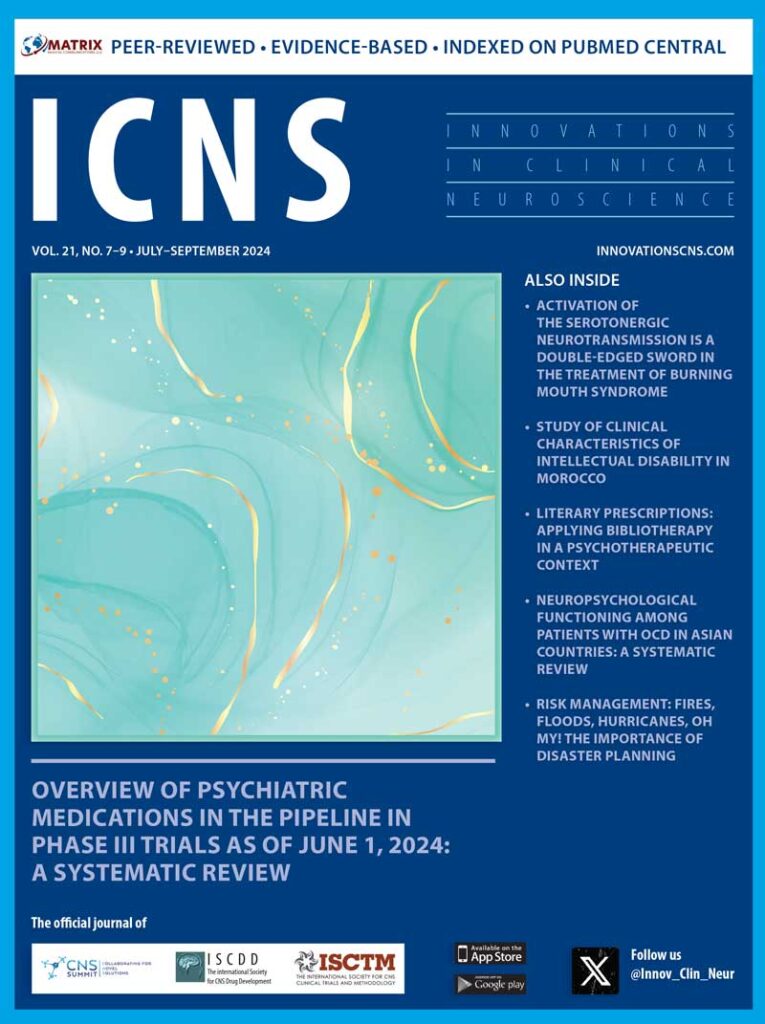
Innov Clin Neurosci. 2024;21(7–9):8–9.
Dear Editor:
In the treatment of chronic pain of unknown cause, contradictions can arise; a drug for the treatment of a disease might be a cause of the disease. Burning mouth syndrome (BMS) is a condition characterized by chronic burning pain and unpleasant sensations in the mouth without any associated abnormalities.1 Despite the relatively large number of patients with BMS in clinical practice, with a prevalence of about two percent of the population, and women being up to seven times more likely to be diagnosed than men, there is little research on appropriate pharmacotherapy for these conditions. Treatment of BMS typically involves the use of antidepressants. However, some antidepressants, such as selective serotonin reuptake inhibitors (SSRIs), have been reported to cause BMS.2 This phenomenon is known as the serotonin paradox because antidepressants primarily enhance serotonergic neurotransmission.3
The mechanism by which antidepressants exert their effects on chronic pain, including BMS, may be through activation of the descending pain inhibitory pathway, which is independent of antidepressant effects.4 The most important neurotransmitter in the descending pain inhibitory pathway is serotonin.5 However, in a genetically engineered mouse model of chronic pain induced by optogenetic stimulation, serotonin stimulation of the descending pain inhibitory pathway conversely enhanced pain.6 Increased midbrain serotonin increases pain sensitivity, and activation of the serotonergic system alone favors facilitation over inhibition of pain. There are seven types of serotonin receptors, from 5-HT1 to 5-HT7, and their subtypes.7 They could function differently in the transmission of pain in the spinal cord. Spinal 5-HT7 receptors reduce pain via gamma amino butyric acid (GABA) interneurons. However, neurotransmission via 5-HT2 and 5-HT3 receptors promotes pain. The effects of serotonin can be reversed by the type of serotonin receptor activated. This mechanism indicates that in chronic pain, increased serotonin acts to facilitate pain, and a serotonin paradox may occur.
Another mechanism by which serotonin potentiates chronic pain is in relation to a decrease in dopamine levels in the brain. The descending pain inhibitory pathway involves the activation of the anterior cingulate cortex and dorsolateral prefrontal cortex in response to pain. Their activity is transmitted through the periaqueductal gray (PAG) via dopaminergic neurons. Serotonin and noradrenaline are then released, sending inhibitory signals to the dorsal horn of the spinal cord.8 Antidepressants suppress pain by increasing the amount of serotonin in the synaptic cleft and by activating the descending pain inhibitory pathway through the spinal 5-HT7 receptors. However, for serotonin to have a pain-reducing effect, it is necessary that the dopaminergic or noradrenergic input to the PAG is crucial. In fact, antidepressants with a strong noradrenaline-increasing effect are more effective in improving chronic pain than those with only a serotonin-increasing effect.4,8 Antidepressant-induced BMS is associated with SSRIs, which increase serotonin levels but have little effect on noradrenaline or dopamine levels.2,9 There might be a mechanism by which an increase in serotonin alone worsens chronic pain. The dopaminergic neurons have two ways of inhibiting pain: the descending pain inhibitory pathway and the reward system. In addition to serotonin, neurotransmitters of the descending pain inhibitory pathway include dopamine and noradrenaline-mediated GABA. Sex differences have been observed in the descending pain inhibitory pathway in mice, with male mice having predominantly dopamine and serotonin and female mice having predominantly serotonin and GABA, which might explain why BMS is more prevalent in women, as the dopaminergic nervous system is weak in the female descending pain inhibitory pathway.10
In the reward system, pain suppression occurs through activation of the dopaminergic neurons in the nucleus accumbens, which is part of the striatum in the basal ganglia.11 The use of SSRIs to increase serotonin levels has been shown to decrease the dopaminergic neurotransmission in the basal ganglia. This, in turn, reduces the ability of the reward system to inhibit pain. Positron emission tomography (PET) studies have shown that patients with BMS have reduced endogenous dopamine levels due to presynaptic dysfunction of the reward system, including the nigrostriatal dopaminergic pathway.12 Moreover, the co-occurrence of depression in SSRI-induced BMS suggests dysfunction in the dopaminergic nervous system.2,9 The increase in serotonin by SSRIs might further disrupt the balance with dopamine and fail to suppress pain through the reward system. In our recent study, the response rate of patients with BMS to amitriptyline, a tricyclic antidepressant, was approximately 50 percent, with worsening cases showing shortening in QTc intervals on electrocardiogram. A negative and statistically significant correlation was observed between the improvement in the visual analog scale and the change in the QTc interval (Spearman rank correlation coefficient: 0384; p=0.0054).13 The degree of pain appeared to increase in correlation with a reduction in the QTc interval, which could indicate a decline in sympathetic control due to a reduction in dopamine concentration in the basal ganglia.
In conclusion, medications that increase serotonin are double-edged swords in the treatment of patients with BMS. The serotonin paradox in patients with BMS can be explained at two major levels. Firstly, chronic pain alters the composition of 5-HT receptors in the dorsal spinal cord, promoting pain in the descending inhibitory pathway. Secondly, serotonin dominance in the brain reduces two pain inhibitory effects with dopamine. One is the signal from the PEG to the descending pain inhibitory pathway and the other is the reward system. Further investigation is necessary to refine clinical pharmacotherapy and better understand the mechanism of the serotonin paradox in patients with BMS.
References
- Headache Classification Committee of the International Headache Society (IHS). The International Classification of Headache Disorders, 3rd edition. Cephalalgia. 2018;38(1):1–211.
- Purohith AN, Chauhan A, Bhandary RP. Sertraline-associated burning mouth syndrome: a rare adverse effect of a frequently prescribed antidepressant. J Clin Psychopharmacol. 2022;42(3):315–316.
- Nagamine T. Serotonin paradox in burning mouth syndrome. J Clin Psychopharmacol. 2023;43(2):188–189.
- Finnerup NB, Sindrup SH, Jensen TS. The evidence for pharmacological treatment of neuropathic pain. Pain. 2010;150(3):
573–581. - Nakamori H, Naitou K, Sano Y, et al. Exogenous serotonin regulates colorectal motility via the 5-HT2 and 5-HT3 receptors in the spinal cord of rats. Neurogastroenterol Motil. 2018;30(3).
- Cai YQ, Wang W, Hou YY, et al. Optogenetic activation of brainstem serotonergic neurons induces persistent pain sensitization. Mol Pain. 2014;10:70.
- Lin H, Heo BH, Kim WM, et al. Antiallodynic effect of tianeptine via modulation of the 5-HT7 receptor of GABAergic interneurons in the spinal cord of neuropathic rats. Neurosci Lett. 2015;598:91–95.
- Dharmshaktu P, Tayal V, Kalra BS. Efficacy of antidepressants as analgesics: a review. J Clin Pharmacol. 2012;52:6–17.
- Alesa A, Kattan W, Albadri A. Antidepressant-induced burning mouth syndrome: a case report. SAGE Open Med Case Rep. 2023;11:2050313X231200999.
- Horii K, Ehara Y, Shiina T, et al. Sexually dimorphic response of colorectal motility to noxious stimuli in the colorectum in rats. J Physiol. 2021;599(5):1421–1437.
- Zhang S, Li T, Kobinata H, et al. Attenuation of offset analgesia is associated with suppression of descending pain modulatory and reward systems in patients with chronic pain. Mol Pain. 2018;14:1744806918767512.
- Hagelberg N, Forssell H, Rinne JO, et al. Striatal dopamine D1 and D2 receptors in burning mouth syndrome. Pain. 2003;101(1–2):149–154
- Nagamine T, Watanabe T, Toyofuku A. QTc shortening on electrocardiogram with amitriptyline may indicate no effect on pain relief in burning mouth syndrome. Clin Neuropharmacol. 2024;47(2):33–36.
With regards,
Takahiko Nagamine, MD, PhD
Dr. Nagamine is with Sunlight Brain Research Center, in Hofu, Yamaguchi, Japan, and Department of Psychosomatic Dentistry, Graduate School of Medical and Dental Sciences, Tokyo Medical and Dental University in Tokyo, Japan.
Funding/financial disclosures. The author has no conflicts of interest relevant to the content of this letter. No funding was received for the preparation of this letter.



